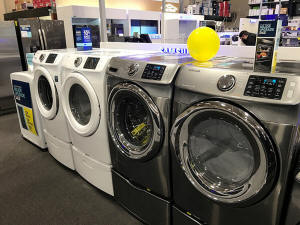US durable goods orders slump; business investment on equipment appears
soft
 Send a link to a friend
Send a link to a friend
 [February 28, 2024] By
Lucia Mutikani [February 28, 2024] By
Lucia Mutikani
WASHINGTON (Reuters) - Orders for long-lasting U.S. manufactured goods
fell by the most in nearly four years in January, while business
investment on equipment appeared to have eased, signs that the economy
lost momentum at the start of the year.
Concerns about the economy's outlook, especially the labor market, and
the upcoming presidential election were uppermost in consumers' minds in
February resulting in confidence retreating after three straight monthly
increases. The decline in confidence reported by the Conference Board on
Tuesday was despite inflation expectations over the next 12 months
falling to the lowest level in almost four years.
The reports joined a stream of weak data, including retail sales,
housing starts and manufacturing production. Some of the softness has
been blamed on freezing temperatures last month as well as difficulties
adjusting the data for seasonal fluctuations at the start of the year.
Nonetheless, economists are not forecasting a recession this year.
"Business capex lays the seeds for future economic growth as the
expenditures enable companies to invest more to meet the demand for
their goods and services down the road," said Christopher Rupkey, chief
economist at FWDBONDS in New York. "While economists have taken down
their recession warnings, business leaders with boots on the ground are
less certain of the economy in the future."
Orders for durable goods, items ranging from toasters to aircraft meant
to last three years or more, plunged 6.1% last month amid a sharp drop
in commercial aircraft bookings, the Commerce Department's Census Bureau
said. That was the largest decline since April 2020, when the economy
was reeling from the first wave of COVID-19 infections.

Data for December was revised lower to show orders falling 0.3% instead
of being unchanged as previously reported.
Economists polled by Reuters had forecast durable goods orders tumbling
4.5%. Orders fell 0.8% year-on-year in January.
Civilian aircraft orders plummeted 58.9% last month after rising 1.0% in
December. Boeing reported on its website that it had received only three
orders for commercial aircraft in January, sharply down from 371 in
December.
The planemaker is under pressure after a cabin panel blew out on an
Alaska Airlines jet mid-air in early January. The Federal Aviation
Administration last month barred Boeing from expanding production of its
best-selling 737 MAX narrowbody planes to improve quality control.
Overall transportation orders dropped 16.2% last month after slipping
0.6% in December. Orders for motor vehicles and parts fell 0.4%.
Excluding transportation, durable goods orders fell 0.3% last month
after dipping 0.1% in December.
There were decreases in orders of primary and fabricated metals.
Machinery orders were unchanged. But orders for computers and electronic
products increased 1.4%, while those for electrical equipment,
appliances and components rose 0.9%.
Though there are signs that manufacturing, which accounts for 10.3% of
the U.S. economy, is stabilizing after production eased in 2023 amid 525
basis points worth of interest rate hikes from the Federal Reserve since
March 2022, a full recovery is still a long way away. While the U.S.
central bank is expected to start cutting interest rates this year,
policymakers have indicated that they are in no rush to lower borrowing
costs.
Stocks on Wall Street were trading lower. The dollar was little changed
against a basket of currencies. U.S. Treasury yields rose.
CONSUMER CONFIDENCE EBBS
Nondefense capital goods orders excluding aircraft, a closely watched
proxy for business spending plans, edged up 0.1% in January after a
revised 0.6% decline in the prior month.

[to top of second column] |

Durable goods are seen on sale in a store in Los Angeles,
California, U.S., March 24, 2017. REUTERS/Lucy Nicholson/File Photo

These so-called core capital goods orders were previously reported
to have gained 0.2% in December. Core capital goods shipments rose
0.8% after nudging up 0.1% in December.
Nondefense capital goods orders plummeted 19.4%, while shipments
fell 3.0%, the largest decline since November 2020, after dropping
1.0% in December. Shipments of these goods go into the calculation
of the business spending on equipment component in the gross
domestic product report.
"This points to a much weaker start for business equipment spending
in the first quarter following a modest gain in the prior quarter,"
said Priscilla Thiagamoorthy, a senior economist at BMO Capital
Markets in Toronto.
Business spending on equipment rebounded modestly in the fourth
quarter after contracting in the July-September period. The economy
grew at a 3.3% annualized rate last quarter after expanding at a
4.9% pace in the third quarter.
Though the labor market has remained resilient in the face of higher
borrowing costs, consumers' assessment of the jobs market is
becoming less rosy and eroding confidence in the economy.
A second report from the Conference Board showed its consumer
confidence index slipped to 106.7 this month from a downwardly
revised 110.9 in January.
Economists had forecast the index little changed at 115.0 from the
previously reported 114.8.
The Conference Board said write-in responses showed that while
consumers remained preoccupied with inflation, "they are now a bit
less concerned about food and gas prices," noting "they are more
concerned about the labor market situation and the U.S. political
environment."
The survey's so-called labor market differential, derived from data
on respondents' views on whether jobs are plentiful or hard to get,
narrowed to 27.8 from 31.7 in January. This measure correlates to
the unemployment rate in the Labor Department's closely followed
employment report.
Consumers' labor market perceptions could have been colored by a
recent wave of high-profile layoffs.
Overall, the labor market remains fairly tight, with first-time
weekly applications for unemployment benefits at historically low
levels. Labor market strength and still-elevated inflation have led
financial markets to push back their expectations of a rate cut to
June from May.

Even as consumers' views of the labor market have softened somewhat,
many still expect to buy a motor vehicle over the next six months as
well as other big-ticket items like clothes dryers and
refrigerators. Consumers expected price pressures to ease over the
next 12 months, with inflation expectations falling to 5.2%, the
lowest level since March 2020, from 5.3% in January.
The share planning to buy a house was the smallest since November
2020 as higher prices and mortgage rates squeeze out aspiring
homeowners.
A third report from the Federal Housing Finance Agency showed house
prices rose 0.1% in December after increasing 0.4% in November. They
advanced 6.6% year-on-year after climbing 6.7% in November. The
moderation in house price growth is welcome, especially from the
perspective of rental inflation, the major driver of overall
inflation.
"The pace of home-price appreciation is consistent with a
deceleration in owner's equivalent rent inflation this year," said
Michael Pearce, deputy chief U.S. economist at Oxford Economics in
New York.
(Reporting by Lucia Mutikani; Editing by Chizu Nomiyama and Andrea
Ricci)
[© 2024 Thomson Reuters. All rights
reserved.]
This material may not be published,
broadcast, rewritten or redistributed.
Thompson Reuters is solely responsible for this content. |